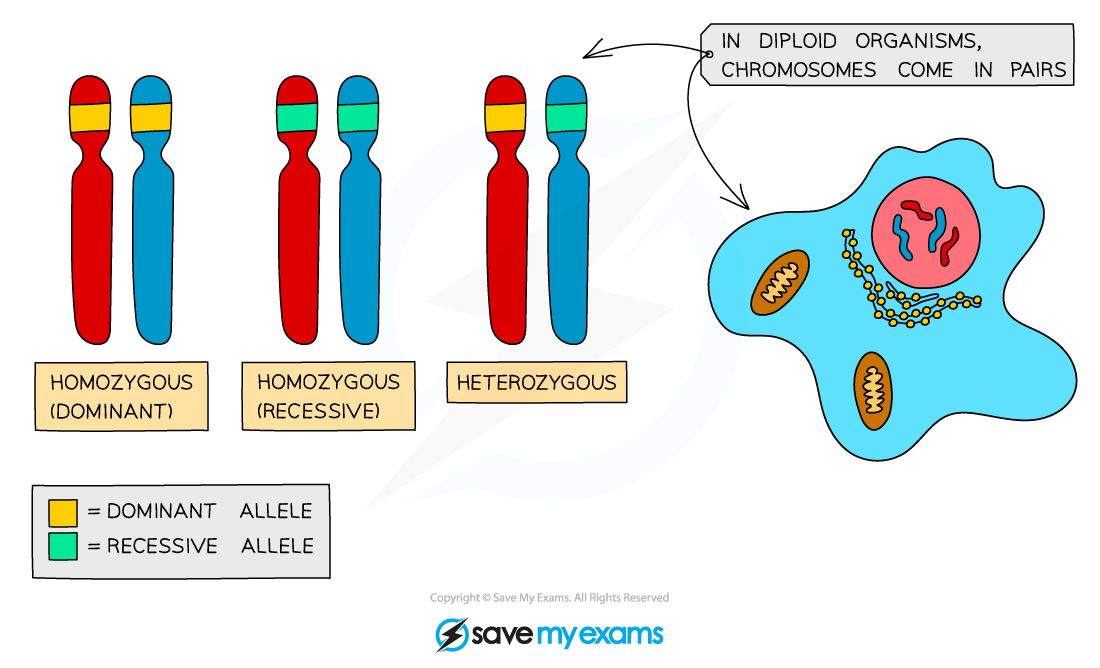Key Terms in Genetics (Edexcel IGCSE Biology (Modular)): Revision Note
Exam code: 4XBI1
Did this video help you?
Key Definitions
The observable characteristics of an organism are called the phenotype
The combination of alleles an organism has for a particular gene is called the genotype
An allele is a single version of a gene, which can be represented by a single letter (eg. B or b)
The genotype is the pair of alleles an organism has for a gene, which can be represented as two letters (eg. BB, Bb or bb)
Alleles can be dominant or recessive:
A dominant allele only needs to be inherited from one parent for the characteristic to appear in the phenotype
A recessive allele must be inherited from both parents for the characteristic to show up in the phenotype.
If only one recessive allele is present in the genotype, it is masked by the dominant allele and the dominant characteristic is shown
The genotype can be homozygous or heterozygous:
If in an organisms genotype two alleles for a gene are the same, the individual is homozygous (homo = same)
An individual could be homozygous dominant - having two copies of the dominant allele, or homozygous recessive - having two copies of the recessive allele)
If the two alleles of a gene are different, the individual is heterozygous (hetero = different)
Dominant alleles are represent by capital letters, and recessive alleles lowercase letters (usually the same letter)
Example PTC tasting:
The ability to taste phenylthiocarbamide (PTC) is controlled by a single gene with two alleles:
T = can taste PTC (dominant)
t = cannot taste PTC (recessive)
Possible genotypes and phenotypes:
TT → taster
Tt → taster
tt → non-taster
PTC itself isn’t found in food, but it tastes similar to bitter compounds in vegetables such as cabbage, kale, and Brussels sprouts. Tasters often find these foods more bitter than non-tasters

Alleles are different forms of the same gene. You can only inherit two alleles for each gene, and they can be the same (homozygous) or different (heterozygous).
Key terms & definitions for inheritance
Key term | Definition | Example |
|---|---|---|
Gene | A section of a molecule of DNA | PTC tasting gene |
Allele | Alleles are alternative forms of genes. Humans have two copies of each gene, and so can have two different alleles for a single gene | T (taster) or t (non-taster) in PTC tasting |
Dominant | Expressed in the phenotype even if only one allele is present | T in PTC tasting |
Recessive | Only expressed in the phenotype if both alleles are recessive (no dominant allele is present) | t in PTC tasting |
Homozygous | Having two identical alleles for a gene | TT (homozygous dominant) or tt (homozygous recessive) |
Heterozygous | Having two different alleles for a gene | Tt |
Phenotype | The observable characteristics of an organism | Taster or non-taster for PTC tasting |
Genotype | The combination of alleles an organism has for a particular gene. | TT, Tt, tt in PTC tasting |
Examiner Tips and Tricks
You do not need to memorise examples like PTC tasting for your exams. In an exam on this topic you may be given an unfamiliar characteristic and asked to determine genotypes and phenotypes.
Focus on understanding the relationships between alleles, genotype, and phenotype:
Dominant allele: shows the characteristic even if only one copy is present.
Recessive allele: only shows the characteristic if both alleles are recessive.
Homozygous: two identical alleles.
Heterozygous: two different alleles.
Use the letter notation method (capital for dominant, lowercase for recessive) to represent alleles and work out genotypes and always state the phenotype based on the combination of alleles in the genotype.

Unlock more, it's free!
Did this page help you?